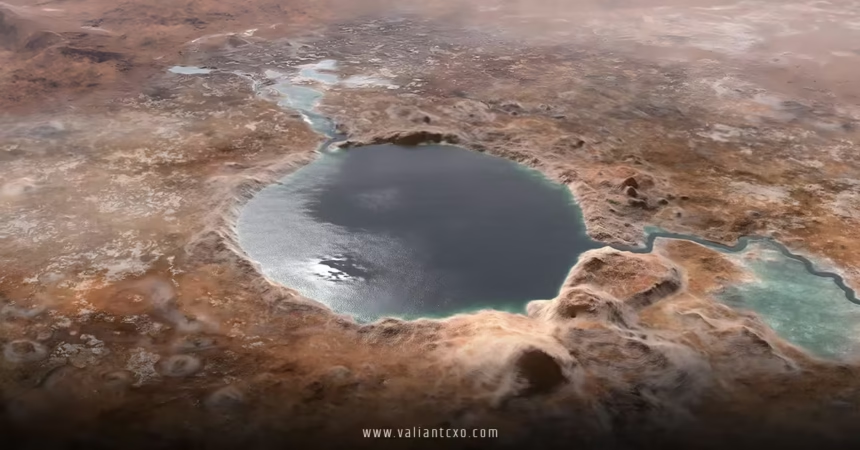Biosignatures in Jezero Crater rock samples NASA has everyone buzzing right now—think about it, tiny clues etched into ancient Martian stones that might whisper secrets of life beyond Earth. As I dive into this mind-bending topic, picture yourself standing on the rusty shores of a long-lost Martian lake, sifting through pebbles that could rewrite our cosmic story. NASA’s Perseverance rover didn’t just scoop up dirt; it grabbed a handful of history that screams potential habitability. But hold on—what exactly are these biosignatures, and why are they turning scientists into wide-eyed kids on Christmas morning?
What Are Biosignatures and Why Do They Matter on Mars?
Let’s kick things off with the basics, shall we? Biosignatures are like nature’s fingerprints—subtle signs in rocks, soils, or atmospheres that hint at life’s handiwork. On Earth, we spot them everywhere: fossilized bacteria in Canadian shale or methane puffs from cow bellies. But flip the script to Mars, and suddenly these clues become gold. Why? Because our red neighbor was once wet and wild, with rivers carving canyons and lakes pooling under pink skies. If life ever sparked there, biosignatures in Jezero Crater rock samples NASA could be the evidence we need to prove we’re not alone.
I remember when I first learned about this—it’s like finding a love letter in your grandma’s attic, faded but full of promise. These signatures aren’t slam-dunk proof; they’re more like intriguing puzzles that demand deeper digs. NASA’s betting big on them because Mars’ past mirrors Earth’s toddler years, around 3.5 billion ago, when microbes were throwing the galaxy’s first parties.
Defining Biosignatures in the Context of Space Exploration
Ever wonder how we tell a rock’s doodle from a microbe’s masterpiece? Biosignatures come in flavors: chemical (organic molecules defying decay), mineral (weird crystals born from biology), and textural (patterns too funky for blind geology). In space hunts, we chase the tough ones—stuff that abiotic processes struggle to fake. Take NASA’s playbook: they flag “potential biosignatures” when features scream biology but could squeak by as chemistry. It’s cautious science, but oh boy, does it fuel the fire.
For biosignatures in Jezero Crater rock samples NASA, we’re talking layered mudstones from a dried-up delta. These aren’t random rubble; they’re sedimentary hugs from ancient waters, trapping organics like flies in amber. Experts like Joel Hurowitz, a planetary whiz, call them “the most compelling yet,” because they pack multiple clues into one rusty punch.
Jezero Crater: The Perfect Hunting Ground
Why Jezero, you ask? Imagine a cosmic bullseye: 28 miles wide, rimmed by cliffs, and fed by a river called Neretva Vallis that dumped sediments into a lake for millennia. NASA’s picked it for Perseverance because it’s a time capsule—layers of clay, sand, and silt that scream “life-friendly.” Billions of years back, this crater hosted a lake deeper than Lake Tahoe, teeming with chemistry ripe for biology. Fast-forward to today, and biosignatures in Jezero Crater rock samples NASA emerge from spots like the Bright Angel formation, a fan-shaped delta edge that’s pure poetry in stone.
It’s not just pretty; it’s practical. Sediments here preserve delicate traces better than igneous blasts elsewhere on Mars. As Sanjeev Gupta from Imperial College puts it, “This is where you’d look for life’s leftovers.” Rhetorical nudge: If you’re a microbe craving a forever home, wouldn’t you pick a cozy crater over a volcano’s fury?
The Perseverance Rover’s Journey into Jezero Crater
Strap in—Perseverance’s tale is straight sci-fi gold. Launched in 2020, this six-wheeled beast touched down in Jezero on February 18, 2021, with a mic to catch the wind’s whisper and lasers to zap rocks. Its mission? Hunt habitability, snag samples, and prep for Earth’s big reveal. Over 1,000 sols (Martian days), it’s roamed 15 miles, drilling into boulders and dodging dunes like a pro gamer.
Me? I’d trade my coffee for a joyride on those treads. The rover’s not alone; it packs a helicopter buddy, Ingenuity, that scouted ahead until its blades gave out. But the real stars are the 24+ sample tubes, sealed treasures waiting for a ride home.
Landing and Initial Discoveries
Picture the descent: skies ablaze, then thud—Perseverance kisses Jezero’s floor amid dust devils. Early wins? Igneous rocks hinting at watery pasts, but the delta’s where magic happened. By mid-2022, it hit Neretva Vallis, unearthing fan deposits that confirmed lake vibes. Organics popped up quick—carbon chains in every other core—teasing biosignatures in Jezero Crater rock samples NASA without spilling the full tea.
These finds weren’t fireworks; they were slow burns, building case by case. Abrasion tools peeled back weathered skins, revealing fresh faces for scrutiny. It’s like skincare for stones—suddenly, hidden patterns glow.
The Sapphire Canyon Sample: A Game-Changer
Enter July 2024: Perseverance lasers onto “Cheyava Falls,” a reddish slab in Bright Angel. Zzzap—leopard spots appear, freckles of fate. It drills the “Sapphire Canyon” core, a mudstone chunk loaded with intrigue. This isn’t just rock; it’s a potential biosignature jackpot, rich in iron, phosphate, and organics. Why game-changer? Because biosignatures in Jezero Crater rock samples NASA like this one layer clues: textures, minerals, chemistry—all singing in harmony.
Hurowitz’s team geeked out: no heat scars to blame on volcanoes, just cool, wet vibes. It’s as if the rock’s saying, “Hey, check my diary—microbes might’ve penned this.”
Biosignatures in Jezero Crater Rock Samples NASA: Key Findings
Alright, let’s unpack the goodies. NASA’s September 2025 bombshell, splashed across Nature, spotlights biosignatures in Jezero Crater rock samples NASA as the “clearest sign yet.” We’re talking mudstones from a 3.5-billion-year-old lakebed, etched with features that mimic Earth’s microbial mischief.
These aren’t vague vibes; they’re lab-vetted specifics. Organic carbon dances with iron oddities, hinting at redox tango—oxidation here, reduction there. Like a Martian soap opera, where chemistry flirts with biology.
The Leopard Spots Phenomenon
Oh, the leopard spots—those eerie white flecks rimmed in black on Cheyava Falls. Up close via Mastcam-Z, they’re nodules of vivianite (iron phosphate) haloed by greigite (iron sulfide). On Earth? Microbes munch organics, exhaling these minerals like burps after dinner. Here? Same setup: low-temp reactions in wet sediments.
But wait—is it cats or chemistry? NASA’s PIXL mapped iron spikes in spots, SHERLOC sniffed organics nearby. No high-heat fingerprints, per Michael Tice, a geobiologist who geeks over such spots. “It’s raising the question: did Mars breathe like Earth?” he muses. For biosignatures in Jezero Crater rock samples NASA, these spots are the plot twist.
Minerals Telling Tales: Vivianite and Greigite
Dive deeper: vivianite’s blue-green crystals form when iron grabs phosphate in oxygen-poor zones—prime microbe turf. Greigite? A magnetic sulfide, birthed by sulfate-munching bugs. In Sapphire Canyon, they’re clustered like gossiping neighbors, linked to “poppy seeds”—tiny black grains of potential hematite.
Analogy time: imagine iron as a shy wallflower at the redox ball; microbes spike the punch, turning it bold. NASA’s SuperCam zapped spectra confirming low-Mg, high-Fe vibes, matching habitable lows. These minerals aren’t loners; they’re tied to organics, amplifying biosignatures in Jezero Crater rock samples NASA.
Organic Matter – The Carbon Clue
Carbon’s the confetti of life—without it, no DNA dances. SHERLOC’s Raman lit up G-bands at 1,600 cm⁻¹ in targets like Apollo Temple, strongest where minerals cluster. No organics in control spots, mind you—just where the action’s hot.
Quantity? Parts per million, but quality counts: diverse chains suggesting biology over comet junk. Tice notes, “It’s not just presence; it’s association.” In biosignatures in Jezero Crater rock samples NASA, organics + minerals = a compelling combo, like peanut butter and jelly for astrobiologists.
How Scientists Analyze These Rock Samples for Biosignatures in Jezero Crater Rock Samples NASA
Science isn’t magic; it’s grind. Perseverance’s toolkit—lasers, X-rays, spectrometers—zaps samples in situ, beaming data home. Dust-off brushes reveal virgin rock, abrasion grinds to millimeter depths. It’s meticulous, like a chef prepping Michelin stars.
Earth labs drool over the tubes, but until return, rover’s the MVP.
Onboard Instruments: SHERLOC, PIXL, and More
SHERLOC’s UV-Raman scans organics like a molecular barcode reader. PIXL’s X-ray fluorescence maps elements pixel-by-pixel—iron hotspots galore. SuperCam blasts LIBS for chemistry, Mastcam-Z snaps 3D vistas. RIMFAX radars subsurface layers, spotting water ghosts.
Together? They paint biosignatures in Jezero Crater rock samples NASA in vivid strokes. Gupta praises: “Context is king—these tools weave geology with geo-bio.”
Earth-Based Analysis: The Next Frontier
Tubes cached in Jezero await pickup—maybe robots, maybe humans in 2030s. Labs here wield electron microscopes, isotope hunters, culturing rigs. Budget woes loom, but urgency spikes: China’s eyeing 2028 return.
For biosignatures in Jezero Crater rock samples NASA, Earth’s the truth serum. “We need that full autopsy,” Hurowitz insists.
Implications for Life on Mars and Beyond
What if? That’s the thrill. Biosignatures in Jezero Crater rock samples NASA nudge Mars from “maybe” to “plausible.” Ancient lake? Check. Organics? Yep. Microbial metabolism echoes? Ding ding.
It reframes us: life’s not Earth-exclusive. But hurdles? Contamination risks, abiotic mimics. Still, it’s a beacon—pushing Artemis, Europa clips.
Could Microbes Have Thrived in Ancient Jezero?
Envision: 3.7 billion years ago, Jezero’s lake laps, rich in sulfates, irons. Microbes, if there, feast on sunlight or chemicals, belching minerals. Tice’s Earth analogs—Australian lakes—mirror the setup. “Habitable? Absolutely,” he says.
Biosignatures in Jezero Crater rock samples NASA bolster the “yes,” but life’s litmus is tough.
Challenges in Confirming Biosignatures in Jezero Crater Rock Samples NASA
Skeptics cry “geochemistry!”—hot springs fake spots aplenty. NASA’s criteria: multiple lines, context fit, no easy abios. Sapphire Canyon ticks boxes, but verdict pends. It’s science’s humility—claim life, stake your rep.
The Road Ahead: Mars Sample Return and Biosignatures in Jezero Crater Rock Samples NASA
Excitement brews: NASA-ESA’s return plan, despite cuts, eyes 2030s launch. Humans? Musk’s Starship dreams. China’s in race—global push for truth.
Meantime, Perseverance drills on, caching more. Biosignatures in Jezero Crater rock samples NASA aren’t endgame; they’re halftime hype.
In wrapping this cosmic yarn, biosignatures in Jezero Crater rock samples NASA stand as tantalizing teases—leopard spots, mineral oddities, organic whispers from a watery Mars. They’ve ignited debates, fueled dreams, and reminded us: the universe might teem with tenants. So, what’s next for you? Dive NASA’s feeds, ponder the stars—because if microbes moseyed Mars, who’s to say we won’t mingle with ET someday? Keep looking up; the red planet’s calling.
Frequently Asked Questions (FAQs)
What exactly are biosignatures in Jezero Crater rock samples NASA?
They’re subtle signs like organic molecules and weird minerals in Perseverance’s scooped mudstones, hinting at ancient microbes without full proof—think detective clues, not confessions.
How did NASA discover potential biosignatures in Jezero Crater rock samples?
Through rover tools zapping rocks in 2024, spotting leopard spots and organics in the Sapphire Canyon sample— a eureka moment after years of scouting the delta.
Are biosignatures in Jezero Crater rock samples NASA definitive proof of life on Mars?
Nope, not yet—they’re “potential,” needing Earth labs to rule out fakes, but they’re the strongest hints we’ve got, exciting experts worldwide.
Why is Jezero Crater ideal for finding biosignatures in Jezero Crater rock samples NASA?
Its ancient lake delta preserved wet-world relics perfectly, like a Martian museum—sediments trap life’s leftovers better than anywhere else.
When will we get more details on biosignatures in Jezero Crater rock samples NASA?
Soonish—sample return in the 2030s could crack it open, with more rover data dropping anytime; stay tuned for Nature-level bombshells.
Read More:valiantcxo.com


